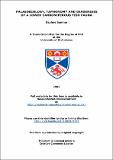Files in this item
Palaeobiology, taphonomy and diagenesis of a lower carboniferous fish fauna
Item metadata
| dc.contributor.advisor | MacGregor, A. R. | |
| dc.contributor.advisor | McPhate, G. F. | |
| dc.contributor.author | Sumner, Daphne | |
| dc.coverage.spatial | 350 | en_US |
| dc.date.accessioned | 2013-06-19T09:12:30Z | |
| dc.date.available | 2013-06-19T09:12:30Z | |
| dc.date.issued | 1991 | |
| dc.identifier | uk.bl.ethos.361154 | |
| dc.identifier.uri | https://hdl.handle.net/10023/3723 | |
| dc.description.abstract | Chapters one and two of this work contain a study of helically-coiled spiral coprolites. Spiral coprolites with complex microstructures have been interpreted as enterospirae – fossilized valvular intestines (Fritsch 1907, Williams 1972). However other evidence seems to indicate that recent dogfish produce spiral faecal pellets with complex microstructures (McAllister 1985). The search for an answer to the problem of whether certain spiral coprolites are fossilized intestines or faecal pellets includes a study of diet and the physiology of digestion in fishes, with particular attention to those with valvular intestines; the sharks, skates and rays. The faunal associations of various coprolite assemblages and the fossil evidence for the presence of the valvular intestine in fishes and other groups are also reviewed. Chapter one includes a revision of the definitions, terminology and taxonomy of coprolites. In the second chapter the various forms of spiral coprolites in the Lower Carboniferous of Scotland are examined. Actualistic research into taphonomic processes in fishes is divided into two areas described in chapters three and five. Chapter three covers various aspects of the physical processes which affect fish carcasses, with particular emphasis on small sharks. A major aspect of this work is concerned with the post mortem build-up of gas in the body cavity and its taphonomic consequences. Chemical aspects of decay and mineralization form the basis of chapter five. The roles of changes in pH and the levels of calcium magnesium and phosphates in early mineralization are investigated. An investigation of the taphonomy and diagenesis of the Wardle Shales fish beds is contained in chapter four. The Lower Carboniferous Wardie Shales fish fauna consists of palaeoniscoids, sharks and acanthodians preserved in siderite concretions. The preservation of uncrushed calcified cartilage is particularly striking. Well-preserved spiral coprolites are exceedingly common. Wide-ranging conclusions help to clarify the processes that have led to the preservation of the remarkable assemblages of coprolites at Anstruther and Wardie and of the Wardie fishes. | en_US |
| dc.language.iso | en | en_US |
| dc.publisher | University of St Andrews | |
| dc.rights | Creative Commons Attribution-NonCommercial-NoDerivs 3.0 Unported | |
| dc.rights.uri | http://creativecommons.org/licenses/by-nc-nd/3.0/ | |
| dc.title | Palaeobiology, taphonomy and diagenesis of a lower carboniferous fish fauna | en_US |
| dc.type | Thesis | en_US |
| dc.type.qualificationlevel | Doctoral | en_US |
| dc.type.qualificationname | PhD Doctor of Philosophy | en_US |
| dc.publisher.institution | The University of St Andrews | en_US |
This item appears in the following Collection(s)
Except where otherwise noted within the work, this item's licence for re-use is described as Creative Commons Attribution-NonCommercial-NoDerivs 3.0 Unported
Items in the St Andrews Research Repository are protected by copyright, with all rights reserved, unless otherwise indicated.


